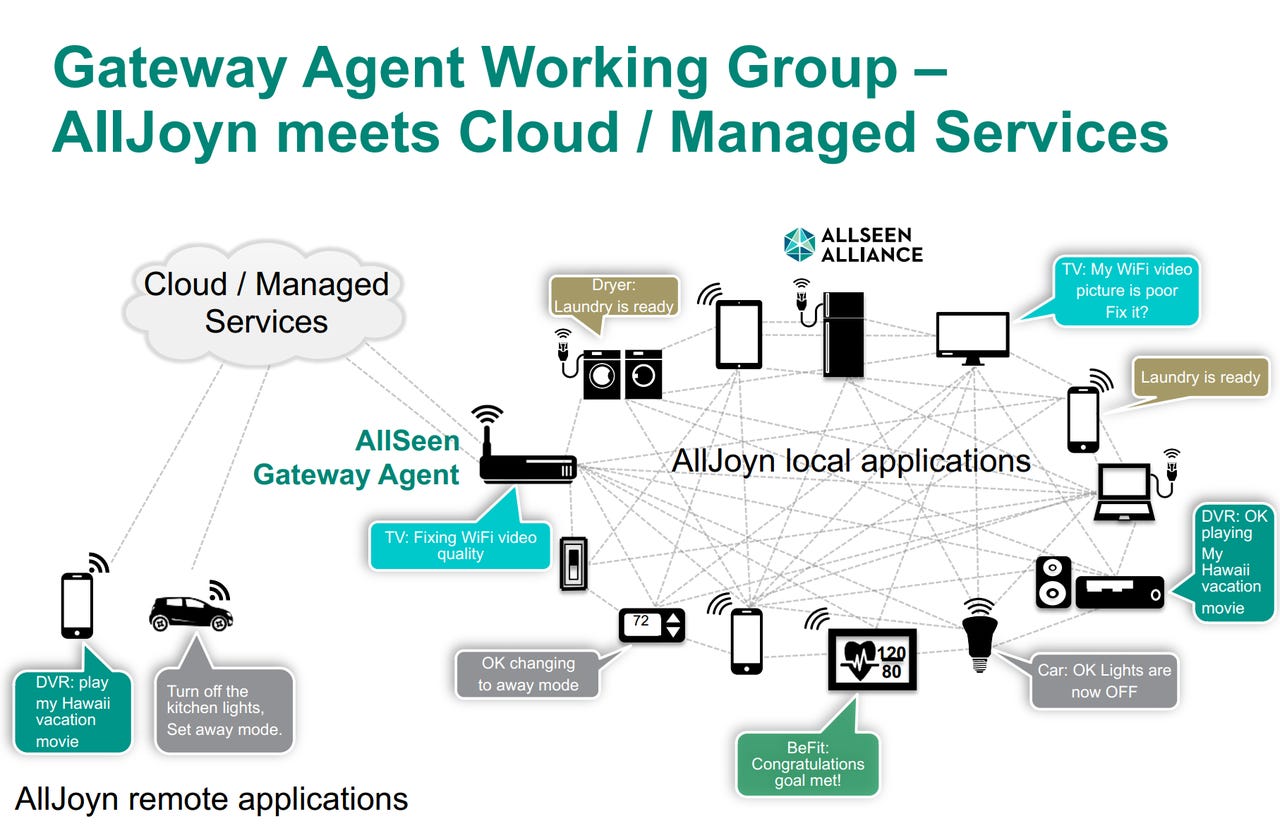CES 2015: AllSeen Alliance to bring order to the Internet of Things

Las Vegas -- Lost among the 4K TVs, 3D printers, and smart baby-bottles at CES, the AllSeen Alliance, a cross-industry group advancing the Internet of Everything (IoT) via the AllJoyn open-source software project, announced the first release of the AllJoyn Gateway Agent. That's a pity, because this announcement may be the most important one of the show.

That's where AllJoyn Gateway Agent comes in. This extension of the AllJoyn framework. provides a standard and secure, remote access method for AllJoyn devices and applications to connect to external/cloud services, personal area networks, and the Internet. Specifically it will provide a secure way to remotely access and manage IoT devices. These in turn will be provided with fine-grained security and privacy control.
The Gateway Agent's key features are:
- Remote access and management: Provides a standard and secure method for connecting local AllJoyn devices and applications to one or more external services through which users and service providers can access and manage AllJoyn-enabled devices and applications.
- Security and data privacy: AllJoyn's end-to-end encryption keeps communications secure. Fine-grained controls let users decide which AllJoyn enabled devices and applications have access to and from user-approved cloud-based services.
- Interoperability: A standard API extends the interoperability already provided by AllJoyn to fully embrace external networks and remote services, by supporting plug-in protocol connectors into a standard AllJoyn Gateway Agent API enabling secure internetworking to cloud services, PAN and wireless technologies (including Bluetooth, ZigBee and Z-Wave) and other networks.
- Supports open standards: Connectors provide connectivity, interaction and integration over a variety of protocols including using REST, XMPP, MQTT and TR-069.
In short, this will turn IoT from being a bunch of gadgets, which just happen to all be hooked to the net, into a manageable system. In addition, the Gateway Agent gives consumers, service providers and device OEMs a secure and easy way to connect to and manage AllJoyn-enabled devices and applications from external networks or cloud-based services.
AR + VR
"There are millions of connected devices on the market and that number is growing exponentially," said Art Lancaster, CTO of Affinegy and chair of the AllSeen Alliance Gateway Working Group, in a statement. "The AllSeen Alliance believes that consumers should have control over these devices and their data--with the assurance that these connections are both private and secure. The AllJoyn Gateway Agent is the industry's first standard way to connect IoT devices and applications with such confidence."
The AllJoyn Gateway Agent is ready to run. To try it yourself you must install it on Linux or OpenWRT based Wi-Fi routers, such as the just released Linksys WRT1200AC, AllJoyn itself already provides connectivity over a variety of protocols and supports persistent remote connections without a special firewall or port settings.
Since the AllSeen Alliance's members include Qualcomm, Cisco, Microsoft, LG, and HTC, I think this software, and the standardization ideas behind it, has an excellent chance of defining how IoT will end up being deployed in the real world.
Of course, AllSeen Alliance isn't the only would be setter of IoT standards. The Open Interconnect Consortium (OIC), announced by Intel and joined by Atmel, Dell, Broadcom, Samsung, and Wind River must also be taken seriously. Still AllJoyn has one vital advantage, and it's one that's enabled one open-source project after another to set the tone in everything from supercomputers to Smart TVs: The group is shipping code and you can use it today.
Working programs trumps PowerPoint projections every time. If I'm right, IoT will be coming a lot sooner than five years.
Related Stories:
- Samsung at CES 2015: Internet-of-Things is not science fiction, but 'science fact'
- Five years until the Internet of Things arrives? Why I hope it's a lot, lot longer
- TechRepublic: I know what you ate last supper: What home sensors will reveal about your life
- Slowly but surely, standards on the way for Internet of Things